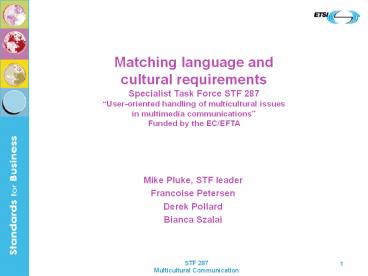STF 287 Multicultural Communication - PowerPoint PPT Presentation
1 / 15
Title:
STF 287 Multicultural Communication
Description:
Derek Pollard. Bianca Szalai. STF 287. Multicultural Communication. 2. ETSI. Develops: ... 'to give everyone the opportunity to participate in the global ... – PowerPoint PPT presentation
Number of Views:87
Avg rating:3.0/5.0
Title: STF 287 Multicultural Communication
1
Matching language andcultural requirementsSpecia
list Task Force STF 287User-oriented handling
of multicultural issues in multimedia
communicationsFunded by the EC/EFTA
- Mike Pluke, STF leader
- Francoise Petersen
- Derek Pollard
- Bianca Szalai
2
ETSI
- Develops
- Wide range of standards
- Other technical documentation
- Contributes to world-wide standards in
- Telecommunications
- Broadcasting
- Information Technology
- Independent but works in close co-operation with
- EU
- ITU
- CEN/CENELEC
- Other world-wide bodies
3
eInclusion
- A key eEurope 2005 objective
- to give everyone the opportunity to participate
in the global information society - Our work
- Seeks to remove or reduce cultural/language
barriers - Is therefore fully in support of this objective
4
Issues
- Information and communication services should
support cultural and language preferences of - a) someone
- communicating with other people or accessing
services in other countries - visiting or residing in a country where the
language is not their native language - who only speaks a minority language of a country
- who only has a limited vocabulary in their own
language - who lip-reads, uses sign language, or the Bliss
symbols system. - b) public and private sector organisations
dealing with customers or organisations in other
countries.
5
The one simple requirement
- In all of these different scenarios, the
requirement is simple - Everyone wants to be able to communicate or
access information in ways that are compatible
with their language and cultural preferences.
6
Counterproductive cultural adaptation
- Organisations often think that they have solved
the language and cultural issues with simple
techniques - These may work for a majority of users
- But for a significant minority they may cause big
problems for the user e.g. - Guessing language from an IP address
- Basing text prediction dictionaries on the user
interface language chosen by the mobile phone user
7
Critical situations
- Some situations where language and cultural
factors are not addressed may have fatal
consequences - e. g Calling emergency services
8
Emergency situation
9
Emergency situation
10
Other scenarios
- Visiting a tourist attraction
- Network announcements
- Communication between a deaf sign language user
and a call centre - Text messaging from a mobile telephone
- Technical business communication
- ..
11
We propose to give guidance on
- Defining levels of language skill and how people
might assess their own capabilities - Storing information about cultural preferences
and language skills - How a service provider can access this
information to deliver an appropriate version of
a service to a user - and
12
and guidance on
- Delivery of content and the handling of user
input taking account of a range of cultures and
languages - Optimising the match of service options to user
preferences - The use of existing standards and guidelines -
identifying where new ones need to be developed - The incorporation of country-specific legal
requirements into business ICT provision
13
How we are going to do it
- Identifying existing standards and
guidelinesincluding ETSI work on User Profile
Management and a Universal Communications
Identifier (UCI) - Extensive consultation with a wide range of
stakeholders, e.g. - Globalisation, internationalisation, localisation
and translation companies - Information service providers
- Other standards bodies e.g. CEN and ISO
- Research projects
- etc.
- Write guidelines
- Identify further work that needs to be done
14
Project Overview
- Work commenced April 2005
- Table of contents and scope June 2005
- Main consultations June December 2005
- Draft for approval by ETSI HF May 2006
- Document publication September 2006
- Final reporting and closure December 2006
15
Summary
- The ultimate aim is .
- Removing or reducing cultural/language barriers
to give everyone the opportunity to participate
in the global information society - Follow the story athttp//portal.etsi.org/STFs/H
F/STF287.asp































